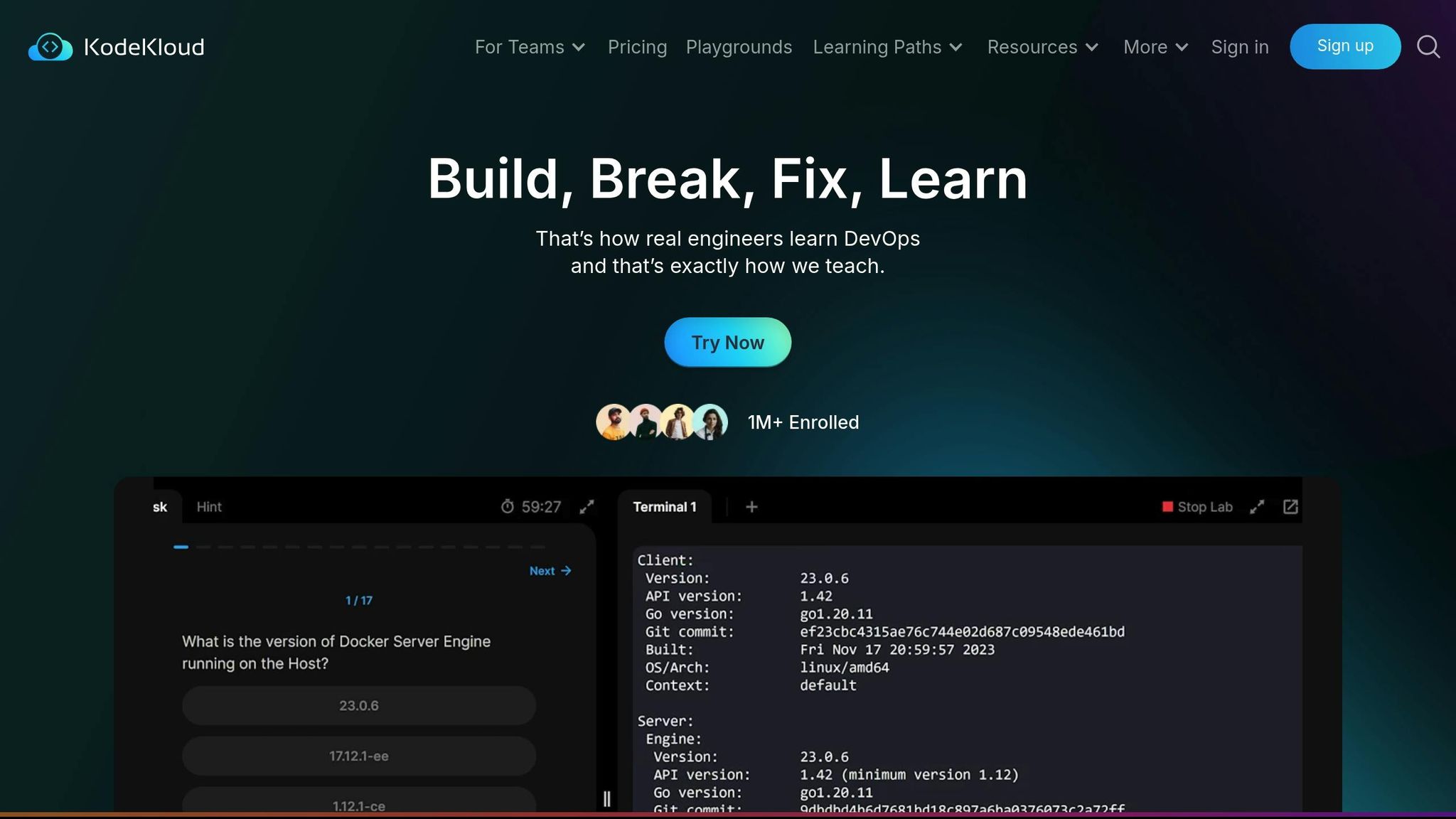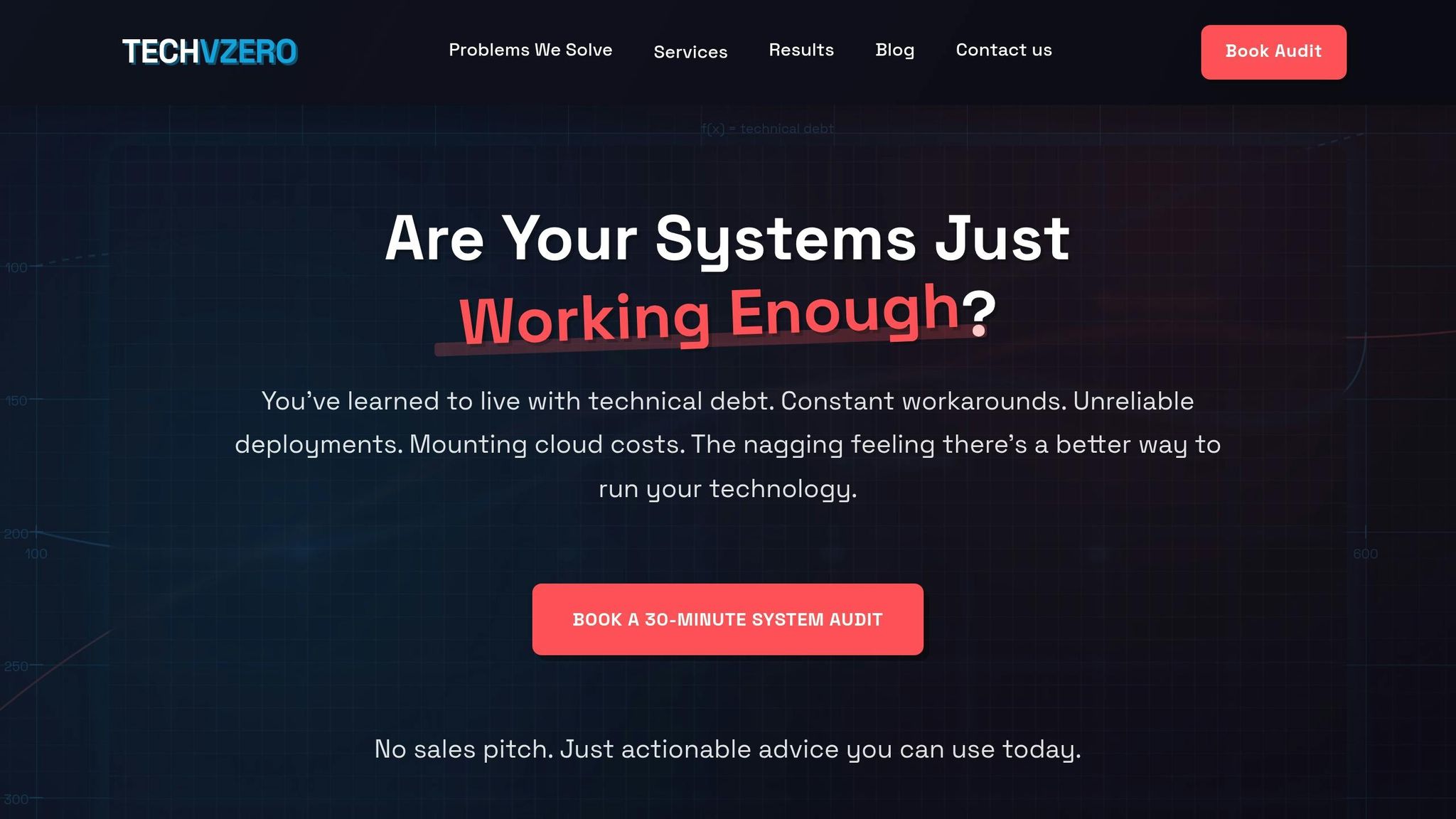SaaS Platform Heads: IaC for Fast, On-Demand Dev Envs

Manual infrastructure provisioning is slowing down SaaS growth. Developers wait days – or even weeks – for environments, while platform teams are stuck with repetitive, error-prone tasks. The solution? Infrastructure as Code (IaC).
IaC automates environment setup, enabling developers to launch full stacks in minutes while freeing platform teams to focus on strategic work. Companies using IaC report:
- 40% faster deployments
- 70% fewer configuration errors
- 2.5x improvement in productivity
By replacing manual processes with automated, consistent workflows, IaC eliminates bottlenecks, reduces errors, and accelerates releases. This shift empowers teams, enhances collaboration, and positions SaaS platforms for scalable growth.
Key benefits of IaC:
- Self-service infrastructure for developers
- Faster, error-free provisioning
- Improved visibility and governance
- Reduced dependency on platform engineers
Transitioning to IaC isn’t just a technical upgrade – it’s a business necessity for SaaS companies aiming to stay competitive.
Infrastructure as Code (IaC) Explained: Types, Tools, and Best Practices | KodeKloud

The Goal: Fast, Automated Development Environments
Picture this: a new developer joins your team and gets the entire application stack up and running before lunchtime – no tickets, no delays, no headaches. This isn’t a pipe dream. It’s the reality when Infrastructure as Code (IaC) reshapes your development workflow. By automating the provisioning process, IaC turns what used to be a bottleneck into a springboard for progress.
With automated and consistent infrastructure, both developers and platform teams can work more efficiently. This approach not only speeds up onboarding but also enhances the overall productivity of your platform.
Enable Developers to Launch Full Stacks Instantly
Self-service infrastructure is a game-changer for development speed. Thanks to IaC, developers can simply run a script to set up their infrastructure – no need to manually configure servers, operating systems, or storage. This shift from reliance on others to self-sufficiency drastically accelerates the development process.
The results speak for themselves. Teams leveraging self-service infrastructure have reported up to 2.5x faster deployments, alongside a noticeable reduction in errors. For instance, Adidas adopted cloud-native architecture, Kubernetes, and DevOps automation, moving from deploying software every six weeks to deploying five times a day [6].
"With Ansible, we’ve transformed our workflow. It’s like having a superpower for scalability and stability."
- James Thomas, CTO of Tech Innovations
Standardized templates further simplify the process, eliminating redundant setup tasks and ensuring consistent, error-free deployments. These templates also address the infamous "works on my machine" problem, saving significant time and frustration.
The boost to developer productivity is immediate. As Shingai Zivuku puts it:
"A well-designed setup is the foundation for efficient software development, allowing developers to focus on creating value rather than fighting with tools and configurations."
Free Platform Teams to Focus on High-Value Work
While developers enjoy rapid setups, platform teams gain the freedom to focus on strategic priorities. Automated provisioning takes repetitive tasks off their plate, giving them the bandwidth to work on initiatives that drive business growth. Features like zero-touch provisioning can increase IT team productivity by as much as tenfold.
At Better, for example, tasks that once took a week can now be completed in minutes. Automated provisioning also offers complete visibility into which tools employees use and how they use them. This level of transparency not only strengthens security but also ensures compliance without adding extra manual work.
This shift in focus is transformative. Gartner predicts that by 2026, 80% of large software engineering organizations will have platform engineering teams acting as internal providers of reusable services, components, and tools for application delivery – up from 45% in 2022.
Common Myths About Infrastructure as Code
Platform teams often hesitate to embrace Infrastructure as Code (IaC) due to widespread misconceptions about what it entails. These misunderstandings can lead to delays or unrealistic expectations, which ultimately hinder adoption. Addressing these myths is essential to crafting an effective IaC strategy that can genuinely enhance your development workflow.
Here’s a telling statistic: only 13% of organizations have achieved IaC maturity. This gap between aspiration and reality often stems from a lack of clarity on what’s required for success. By debunking these myths, teams can shift infrastructure provisioning from a cumbersome bottleneck to a competitive advantage.
IaC Requires Strategy, Not Just Scripts
One of the most common myths is that IaC is simply about writing scripts to automate server setups. Many teams jump straight to choosing tools, skipping over the essential step of developing a thoughtful strategy.
The truth is, IaC goes far beyond coding. It requires planning, governance, and standardized workflows to ensure efficiency, collaboration, and security – not just the adoption of tools. A strong IaC strategy should include:
- Version control for tracking changes
- Modular design for reusability
- Rigorous testing to catch issues early
- Idempotency to ensure consistent results
- Robust security protocols
- Regular reviews and audits
- CI/CD integration for seamless deployment
The challenges teams face highlight the importance of strategy. For instance, 56% of teams struggle with maintaining consistent configurations despite using multiple tools. Additionally, 54% report difficulties in managing those tools, and 45% face confusion over ownership of IaC responsibilities. These issues often arise when teams treat IaC as a collection of scripts rather than a well-structured process with clear governance.
Success Depends on Process, Not Just Tools
Another myth is that IaC success hinges on having the latest tools or hiring experts. This belief places too much emphasis on technical skills and tools, overlooking the importance of robust processes.
The data tells a different story. While 43% of teams report a lack of skills to write effective IaC, 75% of infrastructure stakeholders express frustration with chasing down configuration errors caused by unregulated changes. This highlights a critical issue: weak processes, rather than skill gaps, are often the root cause of IaC challenges.
Success with IaC requires well-defined workflows and proper team training – not just new software. For example:
- Establishing change management protocols to control updates
- Integrating policy checks to catch risky code before production
- Using version control systems for better governance and collaboration
- Adding code linting and validation to CI/CD pipelines
- Setting clear expectations for meeting security and compliance standards
Without these disciplined processes, even skilled teams can struggle with consistency and governance. Poor practices can also lead to knowledge silos and resistance to change, further complicating adoption.
Additionally, frequent switching between tools disrupts focus and highlights the need for standardized workflows. By prioritizing processes over tools, teams can create a scalable foundation for IaC that grows with their infrastructure needs.
At its core, IaC is a key component of DevOps, aligning infrastructure management with the speed and accuracy required for continuous integration and delivery (CI/CD). This alignment isn’t achieved through tools alone – it’s the result of disciplined, well-defined processes. When teams embrace these practices, they not only streamline IaC but also move closer to creating automated, on-demand development environments.
sbb-itb-f9e5962
TECHVZERO‘s Step-by-Step IaC Implementation

Relying on manual provisioning can slow down SaaS growth. TECHVZERO addresses this challenge by introducing advanced Infrastructure as Code (IaC) strategies that enable quick, on-demand environment setup. With a mentorship-driven approach, we don’t just automate infrastructure using tools like Terraform – we also equip your team with the skills to manage and scale it. This turns your platform into a powerful enabler for your development teams.
Our process focuses on building long-term capabilities within your team instead of creating external dependencies. This ensures your platform engineers gain the expertise they need to maintain and expand the IaC system over time. The result? Faster, self-sufficient environment provisioning that supports your growth.
Analyze Your Current Infrastructure and Workflows
Every successful IaC implementation starts with a thorough analysis of your existing infrastructure. This includes servers, databases, networking, and how these components interact. By mapping out these connections, we pinpoint where manual processes are causing bottlenecks.
Our assessment dives into your provisioning workflows, configuration management practices, security protocols, and how you handle different environments (like development, staging, and production). From there, we set clear goals and timelines to eliminate inefficiencies and prepare your systems for growth.
Build Code Templates and Select Tools
With a clear understanding of your current setup, we move on to creating modular templates and choosing the right tools. Tool selection considers your team’s expertise, the cloud platforms you use, and your existing CI/CD systems. For many SaaS platforms, we recommend cloud-agnostic tools like Terraform (which uses Hashicorp Configuration Language) or Pulumi, which lets developers work in familiar programming languages.
Reusable code templates are at the core of this phase. We help your team break down infrastructure code into smaller, manageable modules. These templates are parameterized, making them adaptable across different environments. Together, we determine when to encapsulate complex configurations into modules and when a simpler approach works better.
This collaborative process ensures your team is fully equipped to maintain these templates and use them effectively.
Train Your Team and Set Up Governance
Training your team is essential for achieving the on-demand provisioning model. Through hands-on mentorship, pair programming, and detailed code reviews, we ensure your team not only understands IaC but can also manage it confidently.
For example, a financial services organization recently adopted this approach, forming cross-functional teams to encourage collaboration and knowledge sharing. With a strong mentorship program in place, they transitioned to IaC, achieving significant cost savings and operational improvements.
In addition to training, we establish a governance framework to maintain sustainable IaC practices. This includes implementing policy checks to catch risky configurations before they reach production and ensuring version control is in place. These steps create a solid foundation for IaC practices that can evolve as your SaaS platform scales.
Results: How IaC Speeds Up SaaS Development
Using Infrastructure as Code (IaC) transforms how SaaS companies handle provisioning and development operations. By automating manual processes, it eliminates bottlenecks and enhances efficiency across the board. This shift not only boosts productivity but also has a direct, positive impact on team morale and overall business performance.
Measurable Improvements: Speed and Consistency
Adopting IaC can lead to a 40% boost in deployment efficiency and cut configuration-related failures by 70%. For a SaaS company with 50 engineers, this means less time spent fixing errors and more time focused on innovation.
Provisioning environments, which used to take days or even weeks, now happens in minutes. Developers can create fully functional development environments with a single command, removing delays that once slowed down feature development or testing. This speed becomes a competitive edge when responding to customer needs or market changes.
"Infrastructure as code can deliver transformational agility and efficiency via infrastructure automation." – Gartner
IaC ensures every environment is built using the same, version-controlled configurations. This consistency eliminates the dreaded "works on my machine" issue. By removing manual errors and preventing configuration drift, teams can trust their systems to behave predictably.
With IaC, automation takes center stage. Updates, patches, and scaling tasks that once required manual input now run smoothly through automated pipelines. This streamlined approach allows companies to deliver faster without sacrificing quality.
Team Benefits: Independence and Better Teamwork

The speed gains from IaC also empower teams to work more independently. Developers can instantly provision the environments they need, making onboarding easier and daily workflows more efficient. New hires can start contributing on day one without waiting for manual setup.
Collaboration also improves significantly. IaC configuration files act as a shared resource that enables teams to unify processes and break down silos. Instead of relying on scattered knowledge within IT or operations, all infrastructure expertise is captured in code that anyone can access and understand.
This shared approach transforms platform teams from reactive troubleshooters into strategic contributors. Freed from repetitive provisioning tasks, they can focus on optimizing architecture, enhancing security, and building tools that improve productivity across the organization. This shift often leads to higher job satisfaction and better retention.
Testing and quality assurance also benefit. Developers can easily set up sandbox environments that mirror production, allowing bugs to be caught earlier in the process. This reduces the cost and stress of dealing with issues after deployment.
Cross-functional collaboration thrives when infrastructure becomes accessible and transparent. Product managers can create demo environments for presentations. QA teams can test specific scenarios in isolated setups. Sales engineers can build custom demos for clients – all without burdening the platform team.
This cultural shift, where automation and IaC are seen as essential to business operations, lays the groundwork for sustainable growth. Teams gain confidence in making infrastructure changes, knowing the process is both predictable and reversible. This confidence fuels faster innovation and encourages more ambitious technical projects.
Conclusion: Build Your SaaS Platform for Growth
Shifting from manual provisioning to Infrastructure as Code (IaC) isn’t just a technical upgrade – it’s a necessity for SaaS companies aiming to scale. With the global IaC market projected to hit $2.3 billion by 2027, growing at an impressive 24.0% annually, businesses that hesitate risk being outpaced by competitors who can deploy faster and more efficiently.
Manual provisioning becomes a significant obstacle as teams grow. 30% of organizations report issues from configuration drift, resulting in inconsistent environments and hours lost to debugging. Imagine a 50-engineer team stuck waiting days for environments while your platform team is bogged down with repetitive tasks. This inefficiency doesn’t just slow you down – it jeopardizes your competitive edge.
The message is clear: transitioning to automated IaC is no longer optional.
"IaC is more than just an IT strategy; it’s a business enabler. It promises operational efficiency, cost savings, and robust security. While there might be challenges on the path to adoption, the business benefits are too significant to overlook. For CEOs looking to future-proof their operations and gain a competitive edge, IaC is a worthy consideration."
- Jeff Cratty, Vice President, Cloud & Innovation, Blue Mantis
By adopting IaC, your platform evolves into what every thriving SaaS company needs: a driver of growth, not a bottleneck. With 70% of organizations expected to automate their IT infrastructure by 2025, the question isn’t whether to adopt IaC but how quickly you can make the shift.
Start small. Begin with pilot projects to test and refine your approach. Incorporate version control tools like Git, implement automated testing, and prioritize security protocols from the outset. These steps lay the groundwork for a reliable, scalable, and efficient infrastructure that empowers your development teams.
At TECHVZERO (https://techvzero.com), we specialize in helping Heads of Platform Engineering implement advanced IaC strategies. Using tools like Terraform, we build automated infrastructures that enable on-demand environments. But we don’t stop there – we mentor your team to manage and scale these systems, ensuring your platform becomes a true accelerator for growth.
The choices you make about your infrastructure today will shape your platform’s ability to scale tomorrow. Start building your automated, self-service infrastructure now – your future growth depends on it.
FAQs
What are some common misconceptions about Infrastructure as Code (IaC), and how can you overcome them for a successful implementation?
Many assume that Infrastructure as Code (IaC) is simply about writing automation scripts or that it effortlessly enables switching between cloud providers. But IaC goes beyond just automation – it involves thoughtful design, consistent maintenance, and robust governance. While tools like Terraform can make managing infrastructure easier, achieving true flexibility across cloud providers still requires meticulous planning and provider-specific adjustments.
Another common misunderstanding is that IaC eliminates the need for ongoing effort. In practice, it demands regular updates, vigilant monitoring, and disciplined processes to prevent issues like misconfigurations or even data loss. To address these challenges, focus on team education and implementing best practices. Providing regular training, maintaining clear and thorough documentation, and continually refining processes can help ensure your IaC setup remains scalable, dependable, and supports your team’s long-term goals.
How does Infrastructure as Code (IaC) improve teamwork and efficiency between development and platform teams?
Infrastructure as Code (IaC) transforms the way teams manage infrastructure by automating processes and maintaining consistent environments across development, testing, and production. By defining infrastructure through code, teams can work together more efficiently, cutting down on miscommunication and avoiding problems caused by mismatched environments.
Another major advantage of IaC is that it allows developers to set up their own environments without relying on manual support from platform teams. This not only speeds up development but also encourages a DevOps culture, where developers and platform teams collaborate smoothly to deliver infrastructure that’s both scalable and reliable.
How can a SaaS company effectively transition from manual infrastructure provisioning to Infrastructure as Code (IaC)?
Transitioning from manual infrastructure provisioning to Infrastructure as Code (IaC) can seem like a big leap, but breaking it into steps makes the process much smoother. Start by taking a close look at your current setup. Pinpoint the areas causing the most headaches and define what you hope to achieve – whether that’s quicker environment setups, better consistency, or something else.
Once you’ve got a clear picture, choose IaC tools that fit well with your existing tech stack and business goals. Tools like Terraform and CloudFormation are widely used and worth considering. Take it slow – begin with small, manageable projects to get your team comfortable with IaC best practices. Provide training, use version control to track your infrastructure code, and automate testing to keep everything reliable and easy to maintain.
To keep things running smoothly, adopt a mindset of continuous improvement. Regularly review your IaC processes to ensure they stay efficient, scalable, and aligned with your SaaS company’s growth plans.